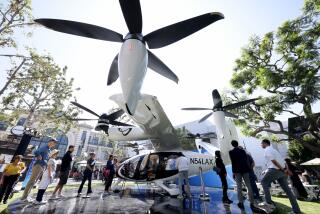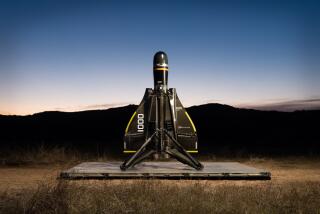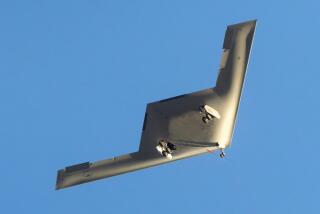Supersonic passenger jets might make a comeback, more than a decade after the last Concorde flight

NASAâs Quiet Supersonic Technology X-plane project aims to solve the problem of sonic booms. (Feb. 2, 2017)
The beak-nosed, supersonic Concorde was once described by a British ambassador as the âflower of the aerospace industry.â
But while the sleek plane could cut travel times in half, it was ultimately doomed by a combination of high maintenance expenses, a slower market for air travel after the Sept. 11 attacks and high ticket prices. A round-trip flight from London to New York could cost as much as $18,260 in todayâs dollars.
Now, almost 14 years after the Concordeâs last flight, a handful of companies and entrepreneurs are betting that technological advances in materials and computing, as well as the boom in global business travel, could power a resurgence in economically viable supersonic passenger jets.
âWeâre benefiting from 50 years of progress in fundamental aerospace technology,â said Blake Scholl, chief executive of Boom Technology Inc., a Centennial, Colo. start-up thatâs aiming to build a supersonic airliner called the Boom. âSince the Concorde was developed, the amount of international business and international travel has skyrocketed. You can find a huge market.â
New supersonic planes, if they get off the ground, will still be comparatively pricey. Analysts predict the technology would be best suited, at least initially, to business jets.
Thatâs the market companies like Aerion Corp. are aiming for. The Reno firm, along with European aviation giant Airbus Group, has been developing the AS2, a supersonic business jet that could shoot through the air at a maximum speed of Mach 1.5, or one and a half times the speed of sound.
A flight from Los Angeles to Tokyo would take about five hours, compared with almost 12 hours today.
âI think its main customers would be very wealthy individuals who would look at it as the ultimate prestige aircraft,â said Ray Jaworowski, senior aerospace analyst at market research firm Forecast International, discussing supersonic jets in general. âIt very much would have its own specific niche.â
But breaking into the business market would require clearing other hurdles. For one, business jet operators are less concerned with speed than they are with range, cabin size and operating costs, Jaworowski said.
The Boom is aiming at the larger airline market. Scholl says his company aims to build a 45-seat aircraft and says the cost to fly supersonic could eventually be the same as a business class seat on a conventional airliner.
The company, which has just more than 20 employees, has received help with manufacturing and flight testing from Virgin Galacticâs Spaceship Co.
Scholl has staked his claim on several advances, including a primary aircraft structure built with carbon fiber composites â like those in the Boeing 787 Dreamlinerâs frame â which should be stronger and lighter than the aluminum exterior of the Concorde.
The engines for the supersonic planes, though, wonât be all that different from those of conventional airliners.
The Boom will have âmedium-sizedâ turbo fan jet engines that have been adapted from a current commercial aircraft and will be modified by âmajorâ engine companies that Scholl would not yet disclose. This decision, contrasting with the Concordeâs famous afterburners, will make the Boom quieter and more fuel efficient, he said.
âThe reason why [Concorde] prices were so high is fuel economy was poor, and there was no economy of scale,â Scholl said. âWe have the technology for that today.â
Scholl said he chose a modified commercial engine rather than a military-grade supersonic propulsion system because of the high emissions standards and efficiency offered by the conventional engines. And from a logistics standpoint, it would be more difficult for military-grade technology to clear export control, he said.
Advances in computing power and speed are also key to developing more efficient supersonic jets. Engineers can now test prototypes through computer models and make tweaks immediately based on those results. Previously, they had to build a plane, test it in a wind tunnel and then tweak the design.
âWeâre now able to bottle physical features in a computer that a short decade ago were unheard of,â said Jim Ladesic, associate dean of industry relations and outreach at Embry-Riddle Aeronautical Universityâs college of engineering in Florida.
The idea of building faster, economic passenger planes has intrigued aerospace companies for years.
In 2001, Boeing unveiled a concept called the Sonic Cruiser, which was to fly almost as fast as the speed of sound, 750 miles per hour. The company said at the time it was working with airlines to determine economic, performance and environmental needs for the concept. But oil prices were rising, and those plans were shelved just a year later as airlines ended up prioritizing fuel efficiency over speed.
Research on the planeâs interior was later incorporated into Boeingâs more efficient 787.
Both Boeing and Airbus have since expressed interest in developing high-speed aircraft. Boeing Chief Executive Dennis Muilenburg has noted several times that the Chicago-based company wants to advance research of hypersonic â Mach 5 or faster â technology.
Boom is currently building a one-third scale model test aircraft that it says will fly for the first time by the end of this year. The actual production aircraft, which will be 60 feet long and weigh 150,000 pounds, could fly its first passengers as early as 2020, Scholl said.
The company has 25 aircraft orders to date. The first 10 will go to British billionaire Richard Bransonâs Virgin Group, and the other 15 are on hold for a European carrier that Scholl declined to name.
One obstacle that may be out of plane makersâ control is the Federal Aviation Administrationâs long-standing ban on supersonic flight by commercial aircraft over land, due to noise concerns about sonic booms. Boom is planning to fly only transoceanic routes to avoid the issue.
But a group of industry leaders, as well as NASA and universities including UC Davis, have helped devise new technologies over the years that could mitigate sonic booms.
One of these efforts is NASAâs Quiet Supersonic Technology X-plane project. Last year, Lockheed Martin Aeronautics Co. in Palmdale won a contract to complete the aircraftâs preliminary design.
The aerospace and defense giant has focused on changing the outer shape of the aircraft, giving it a needle-nose design with a slender fuselage, to alter the distribution of pressure and lift and therefore disperse the supersonic shock waves that cause the traditional boom.
Supersonic planes traditionally generate shock waves from their front and back, which join together in a telltale âNâ pattern to create that sharp crack of sound. The new design separates the waves so they donât join together, said Peter Iosifidis, Lockheed Martinâs program manager for the aircraftâs preliminary design.
That initial work will be completed in June, and a separate competitive contract for a more detailed design could be awarded early next year. NASAâs goal is to fly the plane over populated areas and gauge public opinion of the sound. NASA would then devise a recommendation on an acceptable sound level that would be taken to the FAA for consideration.
Ladesic of Embry-Riddle said itâs unlikely that supersonic planes will expand beyond the business jet market, at least for the foreseeable future. There would need to be a compelling business case that conventional air travelers are willing to pay more for a seat on a speedier plane. Already, some airlines have cut back on first-class seats, and some carriers such as Southwest donât even offer first class.
But he was optimistic about the future prospects for supersonic business jets.
âI think the marketâs always been there,â Ladesic said. âWe just didnât have the right pieces and parts to fit it.â
ALSO
Northrop Grummanâs $35-million contract may point to work on new stealth bomber
Aerojet Rocketdyne chooses Alabama as assembly site for new rocket engine
SpaceX gets new launch order, targets mid-February for next satellite launch
More to Read
Inside the business of entertainment
The Wide Shot brings you news, analysis and insights on everything from streaming wars to production â and what it all means for the future.
You may occasionally receive promotional content from the Los Angeles Times.











